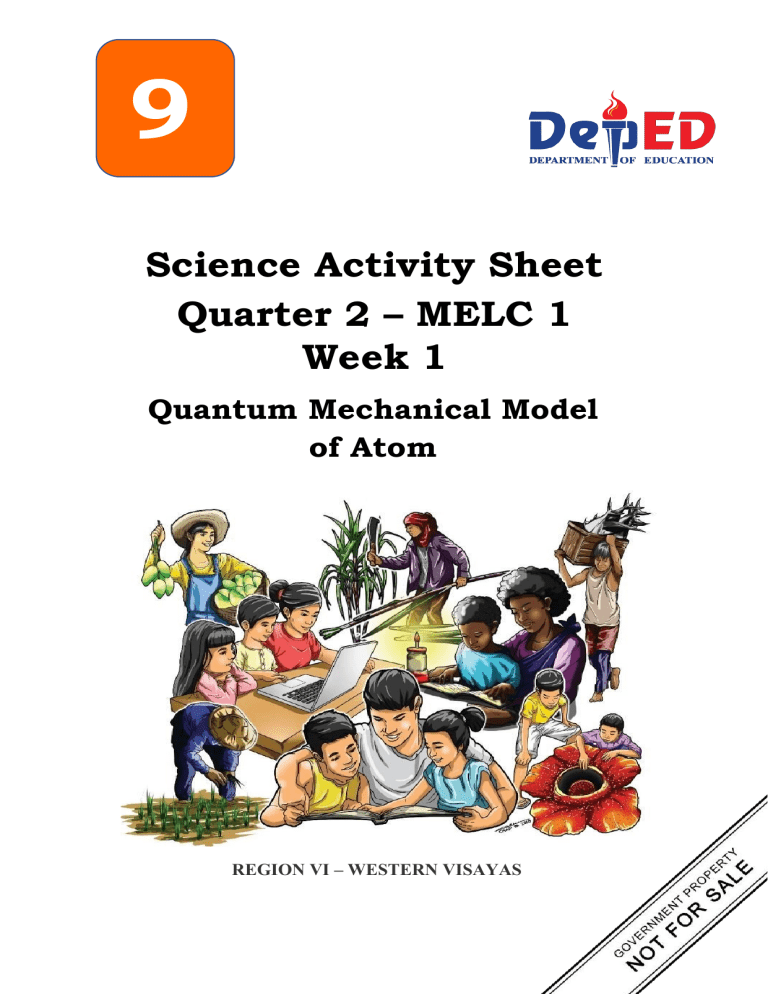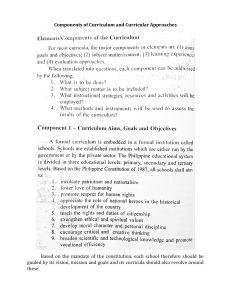
9 Science Activity Sheet Quarter 2 – MELC 1 Week 1 Quantum Mechanical Model of Atom REGION VI – WESTERN VISAYAS Science 9 Activity Sheet No. 1 Quantum Mechanical Model of Atom First Edition, 2020 Published in the Philippines By the Department of Education Region 6 –Western Visayas Republic Act 8293, section 176 states that: No copyright shall subsist in any work of the Government of the Philippines. However, prior approval of the government agency or office wherein the work is created shall be necessary for exploitation of such work for profit. Such agency or office may, among other things, impose as a condition the payment of royalties. This Learning Activity Sheet is developed by DepEd Region 6 – Western Visayas. ALL RIGHTS RESERVED. No part of this learning resource may be reproduced or transmitted in any form or by any means electronic or mechanical without written permission from the DepEd Regional Office 6 – Western Visayas. Development Team of Science Activity Sheet Writer: Benjie G. Reboton Illustrator: Mea L. Basa Lay-out Artist: Eldiardo E. Dela Pena Reviewer: Natalie A. Fernandez, PhD Schools Division Quality Assurance Team: Benjie G. Reboton, Jonah D. Denlos, Rose L. Lizardo, PhD, Merry Joy C. Claur Division of Escalante City Management Team: Clarissa G. Zamora Ermi V. Miranda, PhD Ivy Joy A. Torres, PhD Jason R. Alpay Mae M. Tan, PhD Ethyl S. Gale Regional Management Team: Ma. Gemma M. Ledesma, Dr. Josilyn S. Solana, Dr. Elena P. Gonzaga, Donald T. Genine, Rovel R. Salcedo, DSEd, Moonyeen C. Rivera, EdD, Anita S. Gubalane, EdD, Minda L. Soldevilla, Daisy L. Lopez, Joseph M. Pagalaran i Introductory Message Welcome to Science 9! The Learning Activity Sheet is a product of the collaborative efforts of the Schools Division of Escalante City and DepEd Regional Office VI Western Visayas through the Curriculum and Learning Management Division (CLMD). This is developed to guide the learning facilitators (teachers, parents and responsible adults) in helping the learners meet the standards set by the K to 12 Basic Education Curriculum. The Learning Activity Sheet is self-directed instructional materials aimed to guide the learners in accomplishing activities at their own pace and time using the contextualized resources in the community. This will also assist the learners in acquiring the lifelong learning skills, knowledge and attitudes for productivity and employment. For learning facilitator: The Science 9 Activity Sheet will help you facilitate the leachinglearning activities specified in each Most Essential Learning Competency (MELC) with minimal or no face-to-face encounter between you and learner. This will be made available to the learners with the references/links to ease the independent learning. For the learner: The Science 9 Activity Sheet is developed to help you continue learning even if you are not in school. This learning material provides you with meaningful and engaging activities for independent learning. Being an active learner, carefully read and understand the instructions then perform the activities and answer the assessments. This will be returned to your facilitator on the agreed schedule. ii Name of Learner: ________________________________________________ Grade and Section: ___________________________Date: ______________ SCIENCE 9 ACTIVITY SHEET No. 1 Quantum Mechanical Model of Atom I. Learning Competency with Code Explain how the Quantum Mechanical Model of the atom describes the energies and positions of the electrons II. Background Information for Learners Do you know what scientists believed about the structure of the atom? They believed that electrons are like hyperactive bees buzzing around the nucleus. This is the idea of Erwin Schrodinger and his colleagues which led them to propose an atomic model called the Quantum Mechanical Model. Scientists believed that this is the most plausible atomic model ever made. Imagine that you just took a continuous shot of hyperactive bees buzzing around a beehive. You would probably get different sketches or pictures of it. The same also with atoms, according to Schrodinger, they have various shapes. They are not only the typical circles we found in our old science textbooks and on the internet. Sometimes, atoms look like two teardrops next to each other. Interesting, right? Let’s learn more about the Quantum Mechanical Model of the atom by reading the texts found in your Learning Material on pp. 105 to 109 right after Activity 2. III. Accompanying DepEd Textbook and Educational Sites Department of Education. (2014). K-12 Basic Education Curriculum, Science 9 Learner’s Material (pp. 105-109). Pasig City, Philippines IV. Activity Proper Exercise 1 Directions: Refer to Table 2 in Science 9 Learner’s Module, p. 107 and answer the guide question. Write your answer on a separate sheet of paper. Guide Questions Q1. What do you notice with the number of principal energy level and the number of sublevels? Are they equal or not? Q2. How many types of orbitals are there in principal energy level four (4)? Q3. How many atomic orbitals are there in the highest sublevel of principal energy level four (4)? Q4. What formula did we use to get the maximum number of electrons in each principal energy level? 1 Exercise 2 Directions: Refer to Activity 3 in Science 9 Learner’s Module, p. 108-109. Guide Questions Q1. Do you see the patterns in the distribution of the electrons? If yes, what are these patterns? Q2. What do you think are the rules that apply in filling up the orbitals of the elements from atomic number 1 to 18? V. Reflection How can you relate the different energy levels of electron to your feelings? ________________________________________________________ ________________________________________________________ ________________________________________________________ 2 VI. Answer Keys 3


